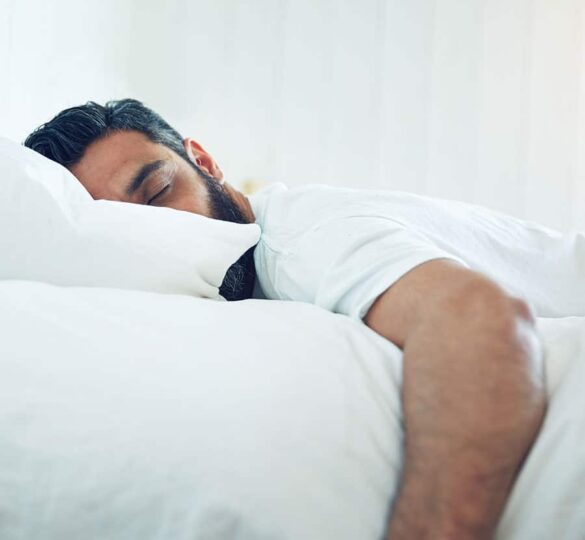Sweet Dreams: The Relationship Between Sleep and Glaucoma
A good night’s sleep isn’t a luxury — it’s a necessity for a healthy life. People with glaucoma need to consider where they lay their heads when it’s time for sleep.

We may be at rest physically while we sleep, but our brains are hard at work while we snooze, building and strengthening the neural connections that are the basis for memory and allowing us to physically and mentally reset.
Research indicates that sleep problems can be a contributing factor to glaucoma progression. Everything from circadian rhythm, sleep positions, sleep apnea, and even the pillow a person uses can impact glaucoma.
Glaucoma and Sleep Problems
Studies suggest that poor sleep—sleep duration, sleep disorders, sleep disturbances, and daytime drowsiness — could be either a risk factor or a result of glaucoma. The study investigated the hypothesized connection between ganglion cell loss and poor sleep, examining the 2005-2008 National Health and Nutrition Examination Survey.
The results established a connection between glaucoma and long and short sleep duration. Glaucoma was three times more prevalent in participants who slept ten or more hours per night than participants who slept seven hours per night. People with glaucoma were also more likely to fall asleep quickly (in nine or fewer minutes) or take longer (30 minutes or more) to fall asleep. There was also a connection between glaucoma and pronounced daytime sleepiness.
Glaucoma and Sleep Apnea
Untreated obstructive sleep apnea (OSA), more commonly referred to as simply sleep apnea, can lead to various serious health problems, such as high blood pressure, heart attack, and stroke. In addition, the dangerous sleep disorder may also lead to vision loss from glaucoma. People who suffer from sleep apnea may be as much as ten times more likely to develop glaucoma, although the reason why is unknown.
Researchers are using innovative contact lenses to track intraocular pressure. The contact lens sensor (CLS) allows for round-the-clock monitoring of intraocular pressure (IOP) without disturbing sleep or interrupting a patient’s nightly routine. The ability to continuously observe IOP, even during sleep, will hopefully provide researchers with new information about the correlation between sleep apnea and glaucoma.
Glaucoma and Sleeping Positions
It’s long been established that IOP levels are higher when people are horizontal than seated. Studies have confirmed that the extent of this difference is more significant in glaucoma patients. It’s also been determined that a person’s preferred sleeping position may contribute some asymmetry to that equation.
Researchers don’t know the exact mechanism contributing to this difference but suspect it likely relates to blood flow changes within the episcleral venous system and the choroid. The study’s authors suggest these dynamics may be significantly associated with the sleeping position and may remain independent of optic nerve perfusion.
One study from South Korea determined that people with worsening glaucoma on just one side were more likely to sleep with the affected eye facing downward. Researchers attribute it to the eye’s internal pressure being raised, accelerating the deterioration of the optic nerve.
Of course, the results don’t suggest that a person’s sleeping position is the sole reason for worsening glaucoma on one side. Still, it does verify a link between preferred sleeping positions and asymmetric visual field loss between eyes.
Glaucoma and Pillows
People with glaucoma also need to consider where they lay their heads when it’s time for sleep. With the knowledge that IOP rises at night or whenever a person is prone, many doctors have advised their patients to sleep in an upright position.
One study found that turning the head into a pillow in a simulated sleep position is associated with a clinically significant increase in estimated IOP. However, investigators found that this eye pressure elevation could be mitigated using protective shielding in the form of glasses that sit on the orbital rim. People who wore the protective glasses showed little to no increase in IOP.
Another study looked at the correlations between head elevation and its effect on IOP. Pressure levels were measured in participants lying flat, using multiple pillows, and using a bed-raising mechanism.
Video: Dr. Leonard Seibold discusses the Relationship Between Sleep and Glaucoma
In this video, Leonard K. Seibold, MD, Professor of Ophthalmology and Glaucoma Fellowship Director at the University of Colorado, shares his expert insights on sleep (and sleep apnea) for glaucoma patients.
Posted on July 12, 2021. Last reviewed on January 16, 2025.